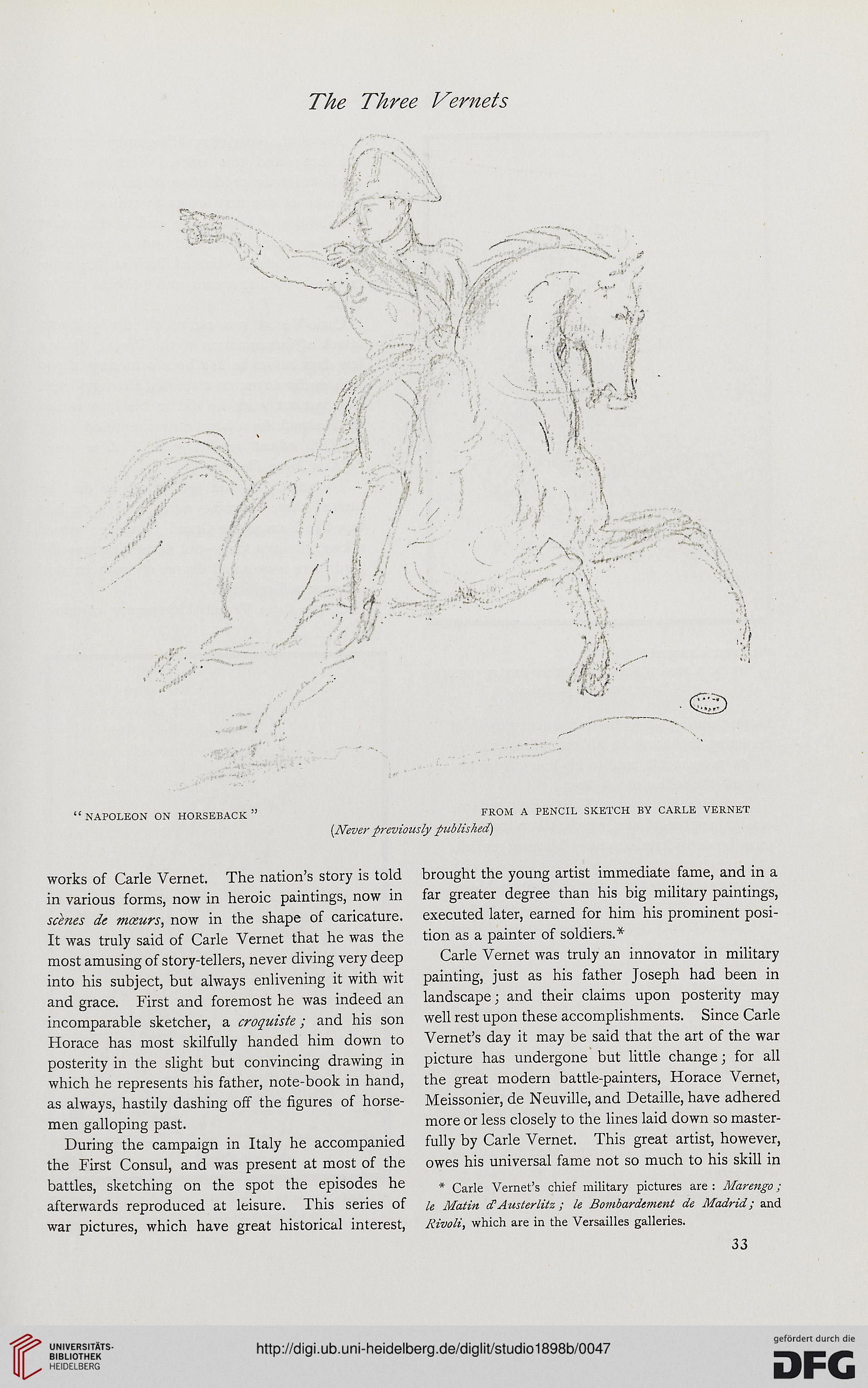The Three Vernets
“NAPOLEON ON HORSEBACK 55 FROM A PENCIL SKETCH BY CARLE VERNET
(Never previously published)
works of Carle Vernet. The nation’s story is told
in various forms, now in heroic paintings, now in
scenes de mceurs, now in the shape of caricature.
It was truly said of Carle Vernet that he was the
most amusing of story-tellers, never diving very deep
into his subject, but always enlivening it with wit
and grace. First and foremost he was indeed an
incomparable sketcher, a croquiste; and his son
Horace has most skilfully handed him down to
posterity in the slight but convincing drawing in
which he represents his father, note-book in hand,
as always, hastily dashing off the figures of horse-
men galloping past.
During the campaign in Italy he accompanied
the First Consul, and was present at most of the
battles, sketching on the spot the episodes he
afterwards reproduced at leisure. This series of
war pictures, which have great historical interest,
brought the young artist immediate fame, and in a
far greater degree than his big military paintings,
executed later, earned for him his prominent posi-
tion as a painter of soldiers.*
Carle Vernet was truly an innovator in military
painting, just as his father Joseph had been in
landscape; and their claims upon posterity may
well rest upon these accomplishments. Since Carle
Vernet’s day it may be said that the art of the war
picture has undergone but little change; for all
the great modern battle-painters, Horace Vernet,
Meissonier, de Neuville, and Detaille, have adhered
more or less closely to the lines laid down so master-
fully by Carle Vernet. This great artist, however,
owes his universal fame not so much to his skill in
* Carle Vernet’s chief military pictures are: Marengo;
le Matin cCAusterlitz ; le Bombardement de Madrid; and
Rivoli, which are in the Versailles galleries.
33
“NAPOLEON ON HORSEBACK 55 FROM A PENCIL SKETCH BY CARLE VERNET
(Never previously published)
works of Carle Vernet. The nation’s story is told
in various forms, now in heroic paintings, now in
scenes de mceurs, now in the shape of caricature.
It was truly said of Carle Vernet that he was the
most amusing of story-tellers, never diving very deep
into his subject, but always enlivening it with wit
and grace. First and foremost he was indeed an
incomparable sketcher, a croquiste; and his son
Horace has most skilfully handed him down to
posterity in the slight but convincing drawing in
which he represents his father, note-book in hand,
as always, hastily dashing off the figures of horse-
men galloping past.
During the campaign in Italy he accompanied
the First Consul, and was present at most of the
battles, sketching on the spot the episodes he
afterwards reproduced at leisure. This series of
war pictures, which have great historical interest,
brought the young artist immediate fame, and in a
far greater degree than his big military paintings,
executed later, earned for him his prominent posi-
tion as a painter of soldiers.*
Carle Vernet was truly an innovator in military
painting, just as his father Joseph had been in
landscape; and their claims upon posterity may
well rest upon these accomplishments. Since Carle
Vernet’s day it may be said that the art of the war
picture has undergone but little change; for all
the great modern battle-painters, Horace Vernet,
Meissonier, de Neuville, and Detaille, have adhered
more or less closely to the lines laid down so master-
fully by Carle Vernet. This great artist, however,
owes his universal fame not so much to his skill in
* Carle Vernet’s chief military pictures are: Marengo;
le Matin cCAusterlitz ; le Bombardement de Madrid; and
Rivoli, which are in the Versailles galleries.
33




